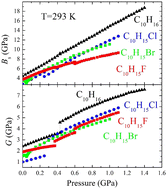Ultrasonic study of 1-X adamantane (X = F, Cl, Br) compounds at high pressure and at order–disorder transitions
Abstract
We present an ultrasonic study of the elastic properties of 1-X adamantane (X = F, Cl, Br) during order–disorder and order–quasi-order transitions at various temperatures (77–305 K) and high pressures (up to 1 GPa). On the basis of our ultrasonic experiments, we studied for the first time the high-temperature (HT) Fm3m, medium-temperature (MT) P42/nmc, and low-temperature (LT) P421c phases of 1-fluoroadamantane at high pressures. The elastic properties of these phases at pressures up to 1 GPa at T = 293 and 77 K, as well as at isobaric heating from 77 to 293 K, have been determined. The boundaries of the HT → MT → LT phase transitions have been evaluated, which makes it possible to extend the phase diagram of 1-fluoroadamantane to higher pressures. We have confirmed that the MT → LT transition is a second-order phase transition because it is not accompanied by volume jumps but is manifested in anomalies of the elastic properties and ultrasound transmission both in high-pressure experiments and under isobaric heating. The comparison of the elastic properties of 1-X adamantanes (X = H, F, Cl, Br) has indicated a monotonic dependence at low pressures: the bulk modulus is the highest for adamantane and decreases with an increase of the atomic number of the halogen substitute (from fluorine to bromine).



 Please wait while we load your content...
Please wait while we load your content...